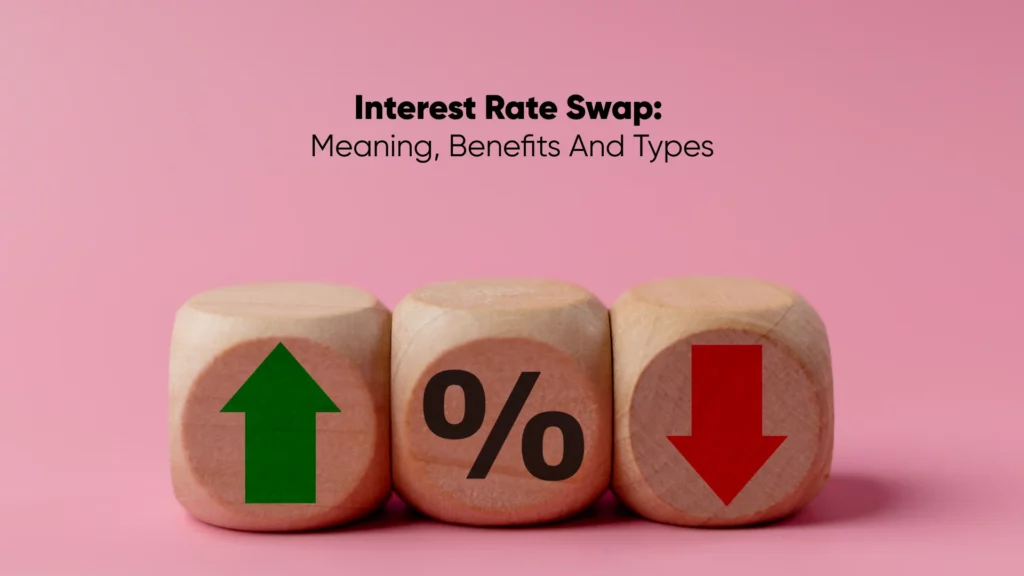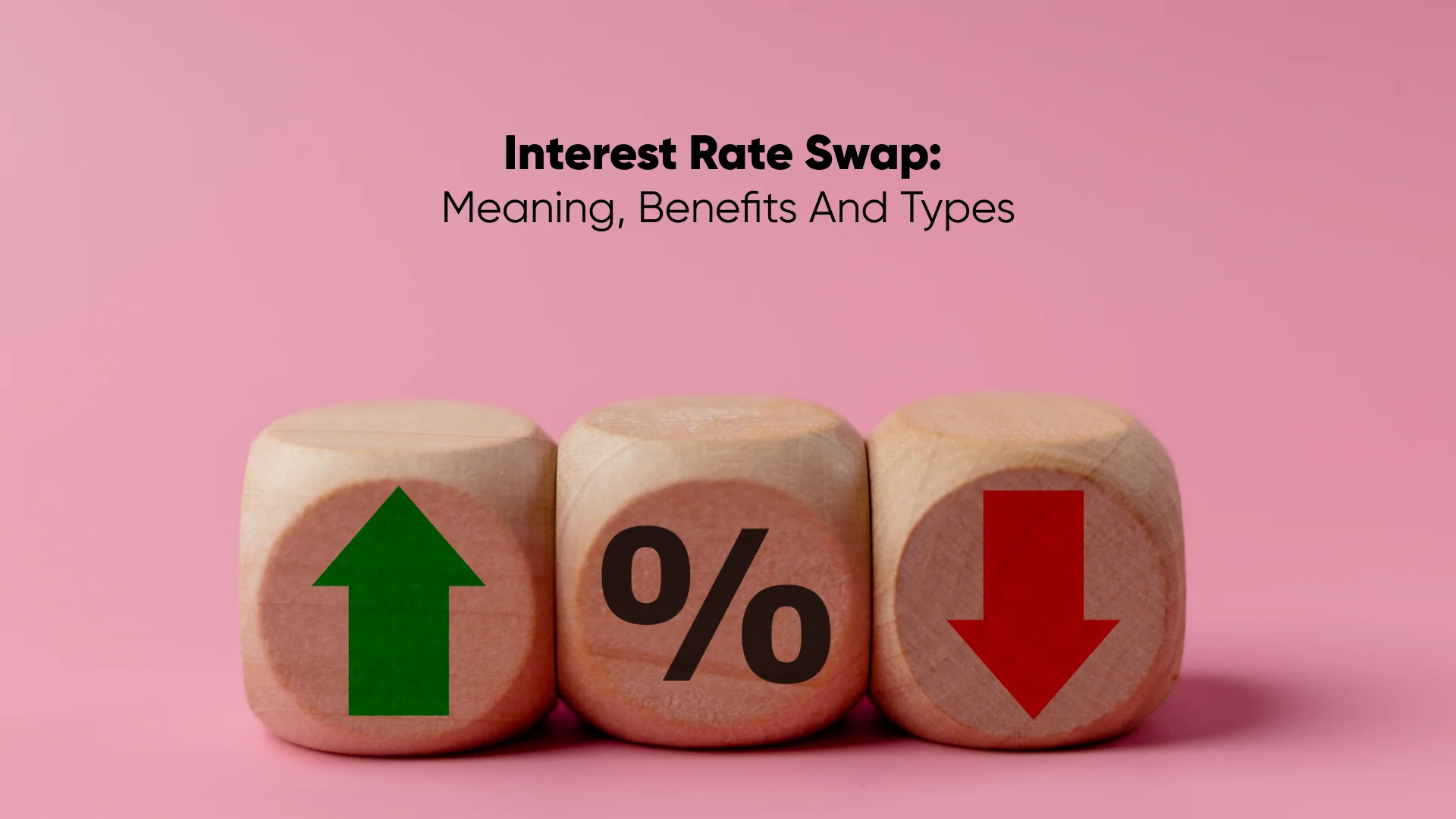Interest Rate Swap: Meaning, Benefits and Types

Table of Contents
ToggleWhat is an Interest Rate Swap?
An interest rate swap (IRS) is a contract where two parties agree to exchange interest payments for a specified principal amount and duration. These derivatives are traded over the counter (OTC) and can be tailored to meet the needs of the parties involved. Key participants in interest rate swaps include banks and both large and small corporations. In India, the Overnight Index Swap (OIS) serves as a prominent benchmark swap.
How does the Interest Rate Swap work?
An interest rate swap is essentially a contractual agreement where two parties exchange their respective loan arrangements. If one party prefers a fixed interest rate while the other favors a floating interest rate, they may mutually agree to swap their loan terms.
In such an arrangement, only the interest payments are exchanged, while the loan amount, tenor, and other payment terms remain unchanged. As a derivative contract, both parties settle the difference in the loan payments rather than paying each other’s debt in full.
A well-structured swap contract outlines the terms, payment obligations, schedule, start date, and maturity date. Both parties are bound by these terms until the contract’s maturity. The main motive for entering into a swap contract is to capitalize on changes in interest rates. For instance, a party exchanging fixed for floating rates may anticipate future rate increases to earn higher interest income. Conversely, parties switching from floating to fixed rates seek to hedge against potential interest rate declines.
In a swap contract, each party achieves its desired outcome. However, only one-party benefits depend on how interest rates evolve. If rates rise, the party receiving a floating rate gain from increased interest income, while the party receiving a fixed rate faces loss. Conversely, if the rate falls, the party receiving a floating rate earns less, while the party with fixed payments maintains consistent interest income.
Types of Interest Rate Swaps
Below are the mentioned few interest rate swap types:
Fixed-to-Floating Interest Rate Swap: In this type of interest rate swap, a participant enters a contract where they receive cash flows at a fixed interest rate and make payments at floating interest rates. The interest is calculated as a percentage of a predetermined principal amount.
Floating-to-Fixed Interest Rate Swap: In this interest rate swap arrangement, a party enters a contract to receive cash flows based on floating interest rates and make payments at fixed interest rates. The interest is determined using a predetermined principal amount.
Float-to-Float Interest Rate Swap: This type of interest rate swap involves parties entering a contract to exchange cash flows based on floating rates referenced to two different benchmarks, using a predetermined principal amount. Companies can also adjust the type or duration of the floating-rate index to secure more favorable rates in this swap.
How to Invest in an Interest Rate Swap?
Float-to-Float Interest Rate Swap can successfully reduce interest rate risk by using interest rate swaps. Risk managers can achieve profitable agreements while ensuring optimal cash flow aligned with the demands of the organisation by trading fixed and floating interest rates. Interest rate swaps can also offer chances to purchase low-liquidity fixed-income securities.
Interest Rate Swap Example:
Here’s one of the Interest Rate Swap Example:
Let’s consider a real estate development company, XYZ Properties, which has borrowed funds at a floating interest rate and anticipates potential interest rate hikes. To hedge against this risk, XYZ Properties has decided to enter into an interest rate swap with a financial institution.
XYZ Properties agrees to pay the financial institution a fixed interest rate of 7% on a notional amount of ₹50 million, while the financial institution agrees to pay XYZ Properties a floating rate based on the Prime Lending Rate. Through this swap, XYZ Properties effectively transforms its floating-rate debt into fixed-rate debt, ensuring stability in its cash flows regardless of interest rate fluctuations.
Advantages & Risks of Interest Rate Swaps:
Advantages of Interest Rate Swaps | Risks of Interest Rate Swaps |
Access to Financing: Enables businesses to access financing based on their preferences and market conditions. | Interest Rate Risk: Fluctuations in interest rates can impact both parties. |
Risk Management: – Helps manage cash flow risks, stabilizing cash flows at desired levels. | Credit Risk: Significant risk related to counterparty default. |
Flexibility: – Highly flexible and customizable to accommodate various needs and strategies. | Basis Risk: – Imbalance in relationship between different interest rates over time. |
To sum up, interest rate swaps are essential financial instruments for optimising debt commitments and controlling interest rate risk. Even if they have a lot to offer, participants need to be aware of the risks. The most efficient way to maximise the utility of Interest Rate Swaps in financial strategies is to understand and manage these risks. Parties can confidently use Interest Rate Swaps to achieve their financial goals while handling the complexities of interest rate variations in the market by properly assessing and reducing risks.
Frequently Asked Questions
Interest rate typically involves exchanging a fixed interest rate for a floating rate, or vice versa. This exchange aims to either reduce, mitigate or amplify exposure to interest rate fluctuations or to secure a slightly lower interest rate compared to what would have been achievable without the swap.
Swap refers to an exchange of one financial instrument for another between the parties concerned. This exchange takes place at a predetermined time, as specified in the contract.
Swap rates serve multiple purposes. One example is companies and investors entering an interest rate swap to manage interest rate risk.
In an interest rate swap, two parties agree to exchange periodic cash flows. One cash flow is determined by a fixed interest rate, which remains constant over the swap’s duration. The other cash flow is linked to a variable index rate.
Assess your interest rate exposure, market conditions, costs, risks, and consult experts to determine the suitability of an interest rate swap for your financial situation.
Swaps help manage cash flow volatility by converting unpredictable cash flows into more stable ones facilitating better budgeting and financial planning.
Yes, interest rate swaps can be utilised for speculative purposes, allowing parties to bet on future interest rate movements and potentially generate profits from interest rate fluctuations.
Typical durations or terms of interest rate swap agreements depend on the specific needs and preferences of the parties involved, market conditions and regulatory requirements.













